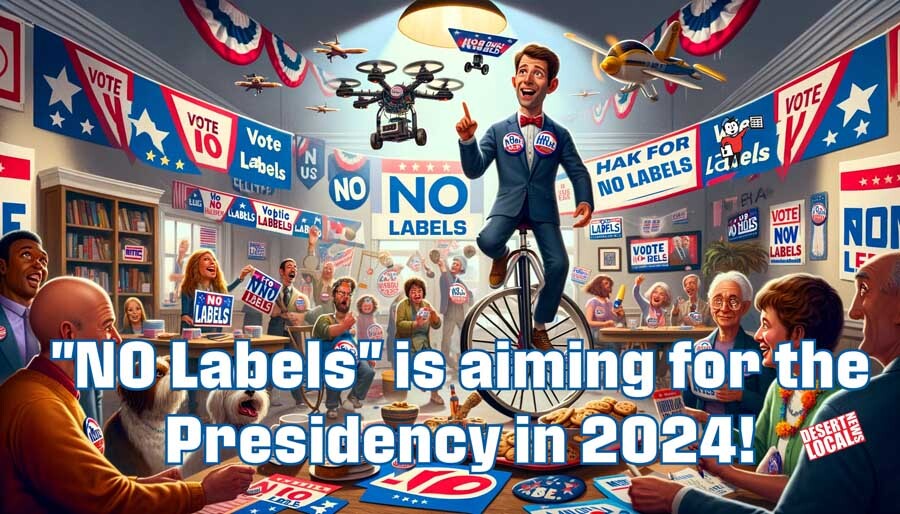 News Staff
News Staff![]() -
March 6, 2024 -
2024 Election
2024 Election
NO Labels for President
Fred Upton
-
2.4K views -
0 Comments -
0 Likes -
0 Reviews
-
March 6, 2024 -
2024 Election
2024 Election
NO Labels for President
Fred Upton
-
2.4K views -
0 Comments -
0 Likes -
0 Reviews

DLNews Politics/2024 Election:
As the 2024 U.S. election gears up, the political landscape is ripe for an unprecedented shake-up, courtesy of a third-party candidacy that neither Donald Trump nor Joe Biden saw coming. Enter "No Labels," a bipartisan initiative aiming to offer disillusioned voters an escape from the binary grip of the two major parties.

The "No Labels" movement of Republicans and Democrats plans to nominate a candidate for the U.S. election.
Co-chaired by Fred Upton, a moderate Republican with a 36-year U.S. House of Representatives tenure, "No Labels" is boldly stepping into the fray. Upton, notable for his principled stand against Trump following the Capitol riot by voting for a second impeachment trial, symbolizes the spirit of the movement. Speaking to "FAZ," Upton highlighted a staggering statistic: "Seventy percent of Americans don't want to have to choose between Biden and Trump again," underscoring the widespread craving for a fresh political alternative.

Fred Upton (70) wants to bring an alternative candidate to the White House with his "No Labels" group.
"No Labels" is meticulously vetting various candidates to represent this third force, with announcements promised in March. This move signals a severe effort to redefine the electoral battleground, aiming to attract voters equally disillusioned with both Trump's divisiveness and Biden's perceived age-related limitations. A New York Times survey amplifies this sentiment, revealing that 61 percent of Biden's 2020 voters now question his efficacy due to age concerns.
Despite skepticism, Upton remains optimistic, refuting claims of one-sided voter appeal by suggesting "No Labels" can equally siphon off support from both camps. This assertion rests on the shaky popularity of both potential major party candidates, with each sporting approval rating languishing below forty percent. Upton's confidence in capturing the necessary 270 Electoral College votes to win the presidency is audacious, echoing the rare but historical precedent set in 1968 when George Wallace, a third-party candidate, secured votes in the Electoral College.

Is a new duel between Biden and Trump inevitable after the Super Tuesday tally and Nikki Haley's exit from the GOP Primary?
The emergence of "No Labels" as a credible third option could be a game-changer in 2024. With a substantial segment of the electorate feeling alienated by the prospect of a Trump-Biden rematch, this initiative could catalyze a significant realignment. Upton's claim, supported by sentiment and statistics, positions "No Labels" as a wild card and a genuine contender, potentially marking a historic pivot in American electoral politics. If successful, "No Labels" could redefine the 2024 election and set a new course for the future of political discourse in the United States.

Electing the President of the United States is a multifaceted and structured sequence of events culminating with the winning candidate moving into the White House. Here's an easy-to-understand breakdown:
Party Primaries and Caucuses
The journey to the White House begins with the primary elections and caucuses, which usually start in January of the election year and can last until the summer. During this period, the Democratic and Republican parties conducted primaries or caucuses across the United States to choose their respective presidential candidates.
- Caucuses are local gatherings where party members discuss and publicly decide on their preferred candidate.
- Primaries: These are more like traditional elections where party members or eligible voters vote for their favorite candidate in a secret ballot.
The process varies by state; during these events, the parties select their single presidential candidate to run in the general election. For 2024, the Democrats plan to finalize their choice by the summer, while the Republicans aim to do so by July.
National Conventions
Following the primaries and caucuses, each party holds a national convention in the summer, at which delegates officially nominate their party's presidential candidate and choose the Vice-Presidential candidate.
General Election
The general election takes place on November 5, 2024. On this day, eligible U.S. citizens (at least 18 years old) cast their vote not directly for their preferred presidential candidate but for a group of electors pledged to that candidate.
Electoral College
The United States uses an Electoral College system to elect the President. The number of electors from each state is roughly based on its population. For example, Texas has 38 electors due to its large population, while Alaska, with its smaller population, has three.
When citizens vote for a presidential candidate, they vote for an elector pledged to that candidate. To secure the presidency, any candidate must win a majority of the 538 electors, at least 270. Most states have a "winner-takes-all" system, where the candidate with the most votes gets all the electors. However, Maine and Nebraska use a proportional system to allocate their electors.
Inauguration
The final step in the journey to the White House is the inauguration. This takes place on January 20, following the election year. The President-elect, who must be a native-born American citizen and at least 35 years old, takes the oath of office and officially becomes the President of the United States, ready to move into the White House and begin their term.
Exceptions in the process, such as the proportional division of electors in Maine and Nebraska, add complexity but are integral to understanding the full scope of the U.S. presidential election system.
At Desert Local News, connections are everything. We're not just another social networking platform—we're a lively hub where people from all walks of life come together to share stories, spark ideas, and grow together. Here, creativity flourishes, communities grow stronger, and conversations spark global awareness.